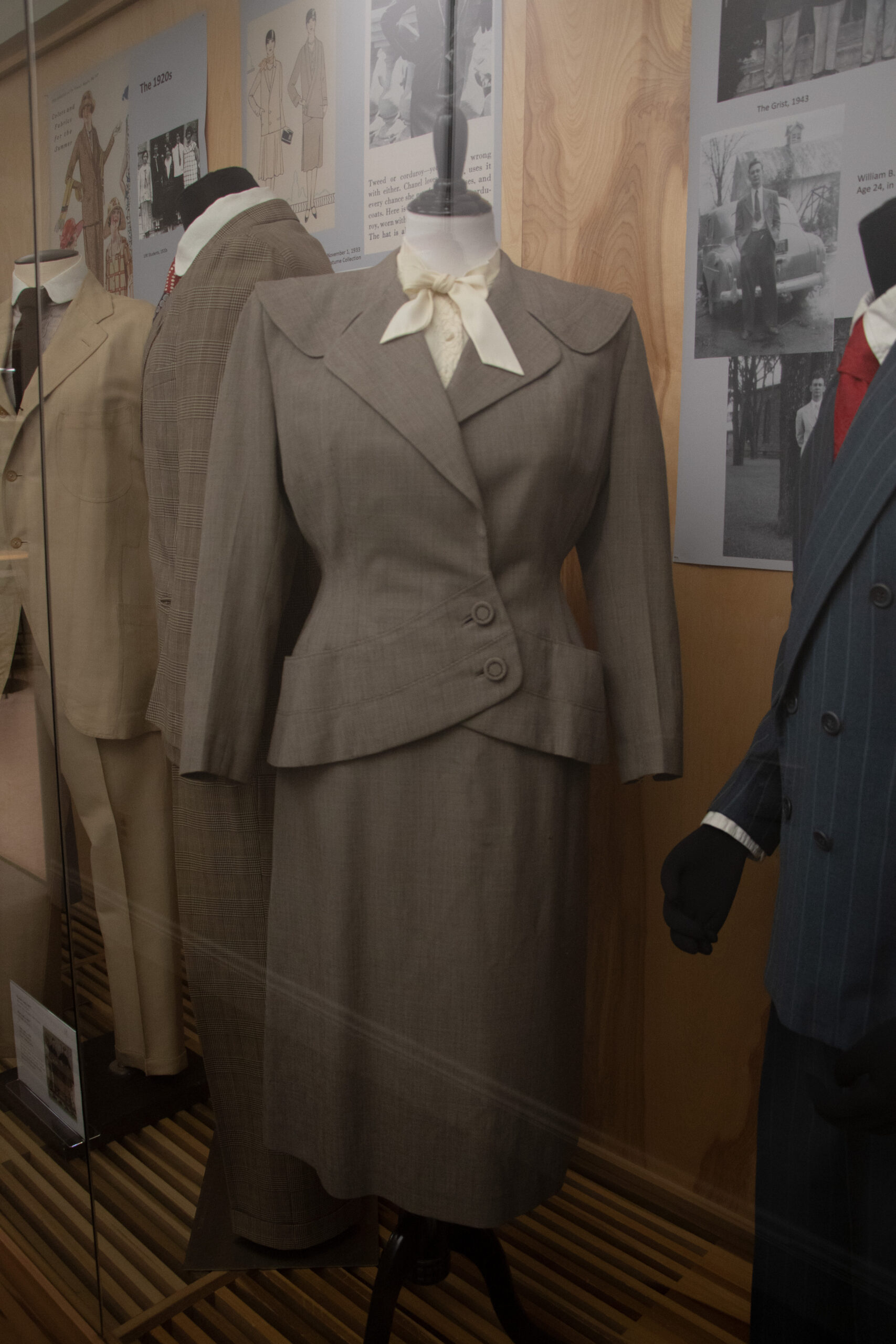URI’s College of Business displays a gallery of business attire through history. PHOTO CREDIT: Connor Zisk | Staff Photographer
To celebrate the College of Business’ 100th anniversary, the department of textiles, fashion merchandising and design (TMD) at the University of Rhode Island opened a new exhibit titled “Dressed for Business: A Retrospective Look at the Suit and Beyond.”
The exhibit, located on the first floor of Quinn Hall, had its grand opening on Thursday, March 23, and will be open until June.
The collection was put together mainly by Rebecca Kelly, a textiles historian, URI alum
and current textiles professor at Rhode Island School of Design, along with Susan J. Jerome, the collections manager in the TMD department at URI.
“It’s the 100th anniversary of the founding of the College of Business here at URI,” Jerome said. “And so, with us [TMD] being a part of the College of Business, it was kind of a no-brainer to do our 2023 exhibit related to that. It’s sort of a look at the history of the suit because the suit is such a large part of the business world, and how you identify yourself as a business person.”
The exhibit features real articles of clothing that are a part of the TMD department’s historic textile and costume collection, located on the third floor of Quinn Hall, according to Jerome. According to the textile collection website, the collection contains over 25,000 objects, and several pieces are donated by Rhode Island families.
Walking through the exhibit, students, community members and any member of the general public can see business suits and attire in order of year they’re from. The exhibit features men’s and women’s attire, ranging from suits, ascots, ties and more from the years 1923-2023.
Two of the pieces, which Jerome said are her favorite in the exhibit, were donated to URI by the nephew of a woman who passed away around 10-12 years ago. The pieces, which are business suits and shoes from the 1940s and 50s, cost $89.95 in 1948, which translates to around $1000 each in today’s economy.
As people walk through the exhibit, Jerome encourages them to pay attention to the fine details and differences in design throughout each decade. As one walks through, they will be able to see “fine details” like differences in the amount of suit buttons and differences in fabric choice as the years go on, she said.
To kickstart the grand opening of the exhibit, TMD professor Linda Welters conducted a 30-minute long presentation about John T. Molloy, an author who wrote the books “Dress for Success” and “Woman’s Dress for Success,” two novels that transformed business attire in the 1970s.
According to Welters, prior to the publishing of the two books, business attire, as well as regular day-to-day attire, in the 1970s was “loud” and featured lots of different patterns and fabrics. At the time, it was popular for men to have long sideburns, long hair and wear colorful items, following the “hippie-era” of the 70’s, Welters said.
However, Molloy thought that business professionals should wear things that are more dialed-down and simple, which led him to write “Dress for Success” in 1975.
“So what Molloy proposes is this return to classic styles, the main navy blue, white, classic styles, nothing too extreme,” Welters said. “Single-breasted and double-breasted suits. And then for fabrics, any solid cover fabrics, and he settled for subtle pinstripes, tweeds and herringbones.”
The book was essentially a guide for businessmen to dress in the way that Molloy deemed to be professional, Welters said, and completely transformed the way that people dressed in the business world in the 1970s.
A few years later, in 1977, Molloy released “Woman’s Dress for Success,” as this was an era in history where more women were entering the corporate world and business workplace, Welters said.
For women, the mini skirt was widely popular for a “number of years,” Welters said, but Molloy argued that women should not wear mini skirts in the workplace because they rode up when they sat down at a desk. Instead, he suggested that women wear midi-skirts, which then rose in popularity.
“Go to the classics, but you shouldn’t look too masculine,” Welters said about the advice that Molloy gave women in the book. “You shouldn’t wear the exact replica of a man with a suit and tie and so on.”
Additionally, Molloy suggested that men and women alike not wear hats in the workplace anymore, something that was widely popular until this point, Welters said. The no-hat look also became popular with the election and presidency of John F. Kennedy, who rarely wore hats in public, according to Welters.
The presentation concluded with Insomnia cookies for all attendees and following the presentation, TMD staff provided tours of the exhibit to those interested in viewing.





